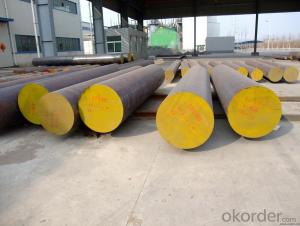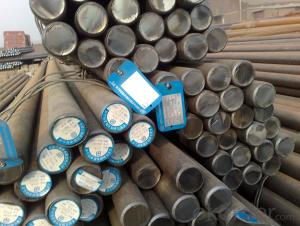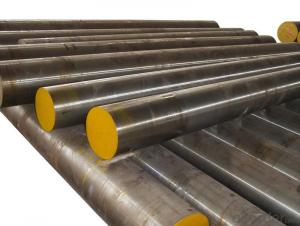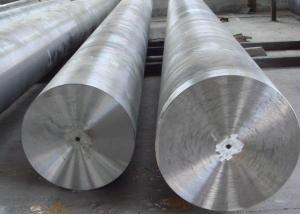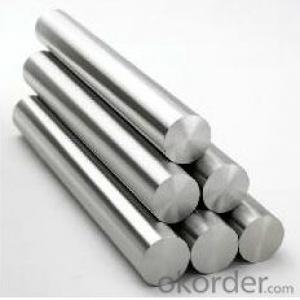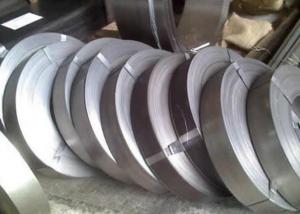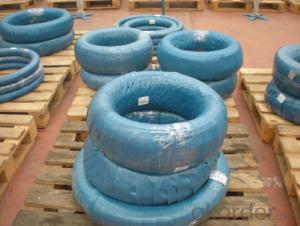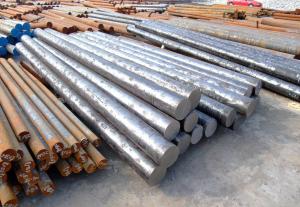9CrWMn Mould Steel Special Steel Carbon Steel
- Loading Port:
- China main port
- Payment Terms:
- TT OR LC
- Min Order Qty:
- 25 m.t.
- Supply Capability:
- 10000 m.t./month
OKorder Service Pledge
OKorder Financial Service
You Might Also Like
Item specifice
Chemical Composition(%)
Country | Standard | C | Si | Mn | Cr | W | S | P | Other |
China(GB) | 9CrWMn | 0.85-0.95 | ≤0.40 | 0.90-1.20 | 0.50-0.80 | 0.50-0.80 | ≤0.30 | ≤0.30 | |
USA(ASTM) | O1 | 0.85-0.95 | 0.20-0.40 | 1.00-1.30 | 0.40-0.60 | 0.40-0.60 | - | - | V:0.20 |
Germany(DIN) | 1.2510 | 0.90-1.05 | 0.15-0.35 | 1.00-1.20 | 0.50-0.70 | 0.50-0.70 | ≤0.35 | ≤0.35 | V:0.05-0.15 |
Japan(JIS) | SKS3 | 0.90-1.00 | ≤0.35 | 0.90-1.20 | 0.50-1.00 | 0.50-1.00 | ≤0.30 | ≤0.30 |
Available Size
Rolled flat steel :12-90mm × 205-610mm × L
Heat Treatment
Processing | Temperature ℃ | Hardness |
Anneal | 740-770 | ≤255HB |
Quenching | 790-840 | 62-65HRC |
Tempering | 180-250 | 58-62HRC |
Characterstics
1.High-carbon and low-alloyed oil quenching tool steel adopted widely in world
2.Higher hardening ability
3.Less deformation after heat treatment
4.High hardness and better abrasion resistance
Applications: Suitable for steel punching dies,shearing blades,measuring devices,thermosetting plastic moulds,etc
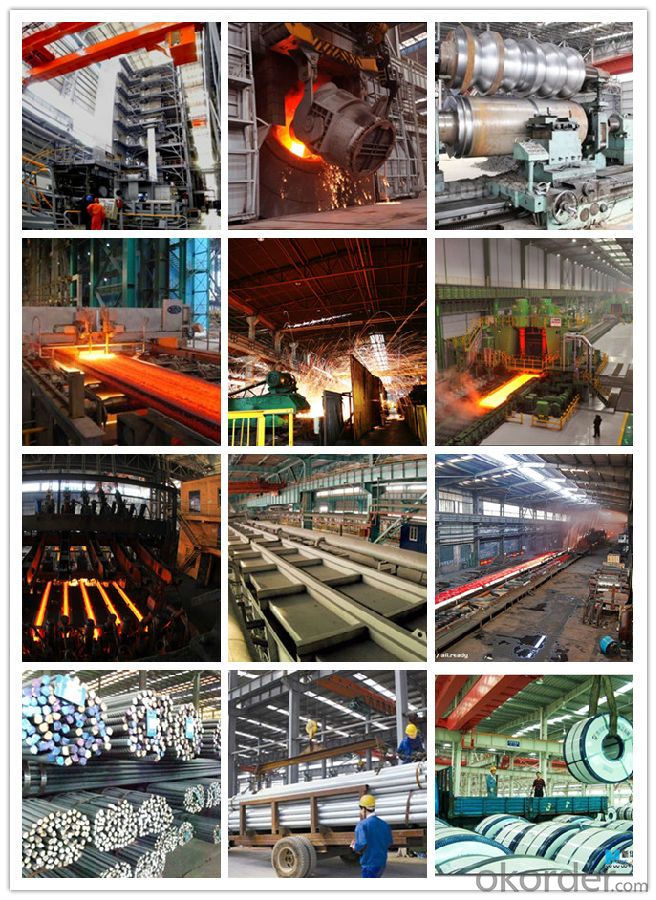
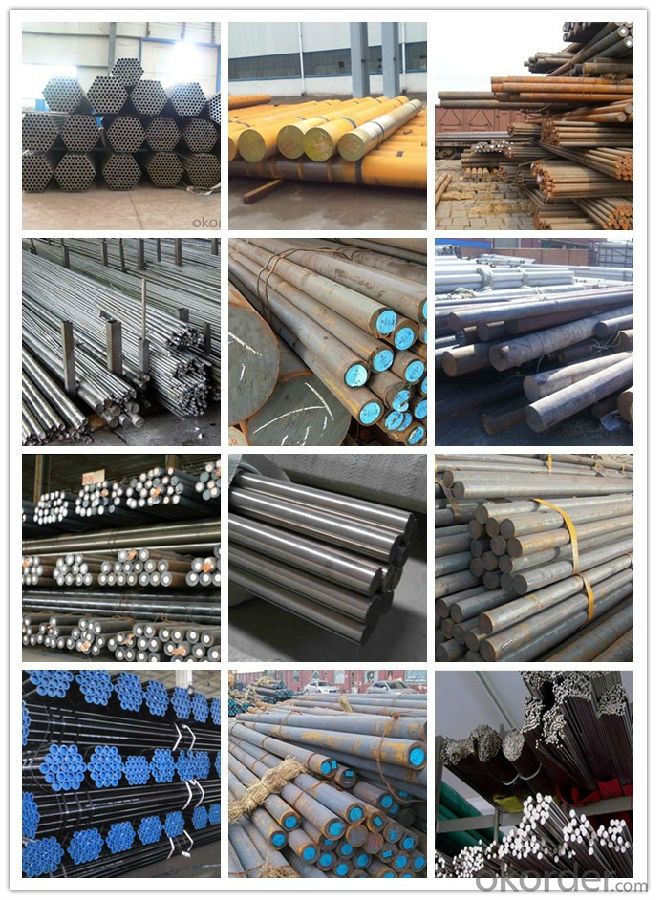
1, Your advantages?
professional products inquiry, products knowledge train (for agents), smooth goods delivery, excellent customer solution proposale
2, Test & Certificate?
SGS test is available, customer inspection before shipping is welcome, third party inspection is no problem
3, Payment Terms?
30% TT as deposit and 70% before delivery.
Irrevocable L/C at sight.
4, Trading Terms?
EXW, FOB, CIF, FFR, CNF
6, After-sale Service?
We provides the services and support you need for every step of our cooperation. We're the business partner you can trust.
For any problem, please kindly contact us at any your convenient time.
We'll reply you in our first priority within 24 hours.
- Q:How does special steel perform in food processing applications?
- Special steel is widely used in food processing applications due to its unique properties and benefits. One of the key advantages of special steel in this industry is its exceptional corrosion resistance. Food processing involves exposure to various corrosive substances such as acids, alkalis, and salt solutions. Special steel, such as stainless steel, has a high chromium content that forms a protective oxide layer on its surface, preventing corrosion and ensuring the hygiene and safety of the processed food. Furthermore, special steel is highly durable and resistant to wear and tear. Food processing equipment often undergoes rigorous and repetitive operations, such as cutting, grinding, and mixing. Special steel's high strength and toughness allow it to withstand these demanding applications without compromising its performance or integrity. This durability ensures a longer lifespan for the equipment, minimizing downtime and maintenance costs. Special steel also offers excellent heat resistance, making it suitable for high-temperature food processing applications. It can withstand extreme temperatures without losing its mechanical properties, maintaining its structural integrity and preventing any contamination risks. Moreover, special steel is easy to clean and maintain, which is crucial in the food processing industry. Its smooth surface and non-porous nature prevent the accumulation of food particles, bacteria, and other contaminants, ensuring a high level of hygiene. Special steel is also resistant to chemical cleaning agents and can be easily sterilized, making it an ideal material for food processing equipment. In summary, special steel performs exceptionally well in food processing applications due to its corrosion resistance, durability, heat resistance, and ease of maintenance. Its properties contribute to the safety, efficiency, and longevity of food processing equipment, ensuring high-quality and hygienic food production.
- Q:How is magnetic alloy steel used in the production of magnetic components?
- Magnetic alloy steel is commonly used in the production of magnetic components due to its unique magnetic properties. It is an essential material for manufacturing products like magnetic cores, transformers, and inductors. The alloy's high saturation magnetization and low coercivity make it ideal for creating strong and efficient magnetic fields. Additionally, its excellent thermal stability ensures reliable performance under various operating conditions. Overall, magnetic alloy steel enhances the functionality and efficiency of magnetic components, making it a crucial material in their production.
- Q:How does hot rolling affect the microstructure of special steel?
- Hot rolling is a metalworking process that involves heating the steel above its recrystallization temperature and then passing it through a series of rollers to reduce its thickness. This process has a significant impact on the microstructure of special steel. During hot rolling, the high temperature causes the grains in the steel to recrystallize, removing any existing defects and creating a more uniform and refined grain structure. This recrystallization process results in smaller and more equiaxed grains, which enhances the mechanical properties of the steel. Additionally, hot rolling promotes the formation of certain microstructural features such as dislocation cells and subgrains. These features help to increase the strength and toughness of the steel, making it suitable for various applications that require high performance and durability. Moreover, hot rolling can also lead to the precipitation of certain alloying elements within the steel. These precipitates can play a crucial role in enhancing specific properties of the steel, such as corrosion resistance or high-temperature strength. Overall, hot rolling has a profound influence on the microstructure of special steel. It refines the grain structure, promotes the formation of beneficial microstructural features, and facilitates the precipitation of alloying elements. These microstructural changes contribute to the improved mechanical properties and performance of the steel, making it a preferred choice in industries such as automotive, aerospace, and construction.
- Q:What are the different surface finishing methods used for special steel?
- Special steel can be subjected to various surface finishing methods, each serving a distinct purpose and yielding different outcomes. The most commonly employed surface finishing techniques for special steel comprise: 1. Grinding: By utilizing abrasive materials, grinding eliminates excessive material from the steel's surface. This method is primarily employed to attain a polished and sleek finish, while also eradicating any imperfections or roughness. 2. Polishing: By utilizing abrasive materials and polishing compounds, polishing creates a smooth and lustrous surface on the steel. This technique is frequently utilized to enhance the steel's visual appeal and bolster its resistance against corrosion. 3. Shot blasting: Shot blasting involves propelling small metallic or mineral particles onto the steel's surface at high velocities. This process effectively eliminates any impurities, rust, or scale, resulting in a clean and uniform finish. 4. Electroplating: Electroplating involves depositing a thin layer of metal onto the steel's surface via an electrochemical reaction. Commonly employed to improve the steel's appearance, corrosion resistance, and provide a decorative or protective coating. 5. Passivation: Passivation, a chemical process, entails treating the steel's surface with an acid solution to eliminate impurities and create a passive layer that resists corrosion. This method is frequently employed to enhance the corrosion resistance of stainless steel and other alloys. 6. Coating: Coating refers to the application of a protective layer or coating onto the steel's surface. This can involve utilizing paints, lacquers, enamels, or other protective coatings to prevent corrosion, enhance durability, or achieve a specific aesthetic finish. It is crucial to note that the selection of a surface finishing method for special steel heavily depends on the desired outcome, ranging from aesthetics to corrosion resistance or functionality. Furthermore, the specific characteristics of the steel, including its composition, hardness, and intended application, significantly influence the most suitable surface finishing method.
- Q:How does special steel perform in high-frequency applications?
- Special steel performs well in high-frequency applications due to its excellent conductivity and high magnetic permeability. These properties allow it to efficiently transmit and handle high-frequency currents and electromagnetic fields, minimizing energy losses and ensuring efficient performance in applications such as transformers, electrical motors, and high-frequency electromagnetic shielding.
- Q:How is special steel stored and transported?
- To maintain the quality and integrity of special steel, it is handled with utmost care during storage and transportation. During storage, the steel is kept in a controlled environment with the right temperature and humidity levels to prevent corrosion and damage. Covered warehouses and storage facilities specifically designed for steel are used to shield it from rain, snow, and sunlight. When it comes to transportation, different methods are employed depending on the quantity and distance. For short distances, smaller amounts of steel are transported using trucks equipped with flatbeds or enclosed trailers. These trucks are designed to securely hold and protect the steel, ensuring it does not shift or get damaged during transit. However, for longer distances or larger quantities, rail or sea transportation is preferred. Rail transportation offers a smooth and stable journey, minimizing the risk of damage caused by vibrations or sudden movements. Specially designed railcars are used to securely store and protect the steel during transit. Sea transportation involves loading the steel onto shipping containers or specialized vessels. Containers are sealed and secured to prevent any movement or damage during the journey. Specialized vessels, such as roll-on/roll-off ships or heavy-lift vessels, are used for oversized or extremely heavy steel components. In all cases, special steel is carefully packaged and secured using appropriate materials like wooden crates, steel strapping, or plastic wrapping to prevent scratches or dents. The transportation process is closely monitored, and necessary precautions are taken to ensure the steel reaches its destination in optimal condition. Overall, the storage and transportation of special steel require thorough planning, proper handling, and the use of specialized equipment to safeguard its quality and protect it from potential damage or degradation.
- Q:What are the main characteristics of corrosion-resistant castings?
- Corrosion-resistant castings are designed to withstand the damaging effects of corrosion, a natural process that deteriorates the surface of metals due to chemical reactions. These castings possess several main characteristics that make them resistant to corrosion. Firstly, corrosion-resistant castings are made from specific alloys or materials that are inherently resistant to corrosion. These materials may include stainless steel, nickel-based alloys, or high-performance alloys like Inconel or Hastelloy. These alloys contain elements such as chromium, molybdenum, or nickel that form a protective layer on the surface of the casting, preventing the corrosive agents from reaching the underlying metal. Secondly, these castings are produced using meticulous casting techniques that ensure a dense and defect-free structure. This is vital in preventing the penetration of corrosive substances into the casting. Techniques such as investment casting or vacuum casting are commonly employed to achieve a high level of precision and quality. Another important characteristic of corrosion-resistant castings is their ability to resist various types of corrosion, including general corrosion, pitting corrosion, crevice corrosion, and stress corrosion cracking. General corrosion refers to the gradual, uniform deterioration of the metal surface, while pitting corrosion creates localized holes or pits. Crevice corrosion occurs in confined spaces, such as gaps or joints, and stress corrosion cracking results from the combined effects of stress and a corrosive environment. Corrosion-resistant castings are designed to withstand all these corrosion types, ensuring long-term durability and reliability. Furthermore, corrosion-resistant castings often undergo additional surface treatments or coatings to enhance their resistance to corrosion. These treatments may include passivation, where the surface is chemically treated to form a protective oxide layer, or the application of protective coatings such as epoxy or polyurethane. These treatments provide an extra layer of defense against corrosive agents, extending the lifespan of the casting. In summary, the main characteristics of corrosion-resistant castings are the use of corrosion-resistant alloys, meticulous casting techniques, resistance to various types of corrosion, and the application of surface treatments or coatings. These characteristics ensure that these castings can withstand harsh environments and maintain their structural integrity over time, making them ideal for applications where corrosion is a significant concern.
- Q:How does special steel perform under low temperatures?
- Special steel performs well under low temperatures due to its high strength, toughness, and resistance to brittle fracture. It retains its mechanical properties and does not become brittle like other materials, making it suitable for applications in cold environments.
- Q:How is structural steel used in building construction?
- Structural steel is extensively used in building construction due to its high strength and versatility. It serves as the primary framework for buildings, providing support and stability. The steel beams and columns are used to create the skeleton of the structure, spanning large distances and allowing for open floor plans. Additionally, steel is used for various other elements such as stairs, handrails, and roof trusses. Its durability, fire resistance, and ability to withstand extreme weather conditions make it an ideal material for constructing high-rise buildings, industrial facilities, and bridges.
- Q:What are the characteristics of special stainless steel?
- Special stainless steel is known for its unique properties that set it apart from regular stainless steel. Some of the key characteristics of special stainless steel include: 1. High Corrosion Resistance: Special stainless steel has a higher level of corrosion resistance compared to regular stainless steel. It can withstand exposure to harsh environments, such as saltwater or acidic substances, without corroding or deteriorating. 2. High Temperature Resistance: Special stainless steel is designed to withstand high temperatures without losing its structural integrity. It can endure extreme heat, making it suitable for applications in industries like aerospace, automotive, and power generation. 3. Enhanced Strength and Durability: Special stainless steel is often alloyed with other elements to enhance its strength and durability. This makes it highly resistant to deformation, cracking, and wear, ensuring its longevity and reliability in demanding conditions. 4. Excellent Mechanical Properties: Special stainless steel exhibits exceptional mechanical properties, including high tensile strength, toughness, and ductility. These properties make it ideal for applications that require high load-bearing capacity, such as structural components and machinery. 5. Unique Magnetic Properties: Depending on its composition, special stainless steel can exhibit various magnetic properties, ranging from non-magnetic to highly magnetic. This versatility allows it to be used in applications where magnetic properties are required, such as magnetic resonance imaging (MRI) machines or electrical transformers. 6. Hygienic and Easy to Clean: Special stainless steel is known for its hygienic properties, which make it suitable for applications in the food and healthcare industries. It is non-porous, resistant to bacteria growth, and easy to clean, making it an ideal choice for equipment and surfaces that require strict sanitary standards. 7. Aesthetic Appeal: Special stainless steel is often used in architectural and design applications due to its aesthetic appeal. It can be polished to a mirror-like finish, giving it a sleek and modern look. Additionally, it can be easily shaped and welded, allowing for creative design possibilities. In summary, special stainless steel possesses a combination of high corrosion resistance, temperature resistance, strength, durability, excellent mechanical properties, unique magnetic properties, hygienic features, and aesthetic appeal. These characteristics make it a preferred choice for a wide range of industrial, commercial, and domestic applications.
1. Manufacturer Overview |
|
|---|---|
| Location | |
| Year Established | |
| Annual Output Value | |
| Main Markets | |
| Company Certifications | |
2. Manufacturer Certificates |
|
|---|---|
| a) Certification Name | |
| Range | |
| Reference | |
| Validity Period | |
3. Manufacturer Capability |
|
|---|---|
| a)Trade Capacity | |
| Nearest Port | |
| Export Percentage | |
| No.of Employees in Trade Department | |
| Language Spoken: | |
| b)Factory Information | |
| Factory Size: | |
| No. of Production Lines | |
| Contract Manufacturing | |
| Product Price Range | |
Send your message to us
9CrWMn Mould Steel Special Steel Carbon Steel
- Loading Port:
- China main port
- Payment Terms:
- TT OR LC
- Min Order Qty:
- 25 m.t.
- Supply Capability:
- 10000 m.t./month
OKorder Service Pledge
OKorder Financial Service
Similar products
New products
Hot products
Related keywords

